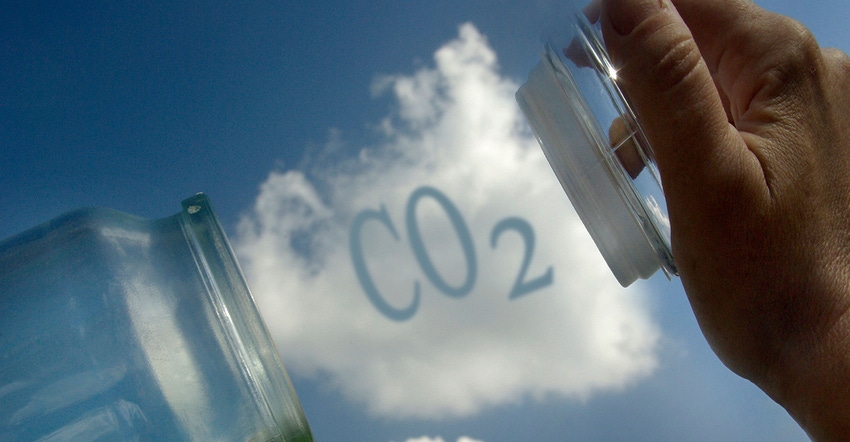The US Department of Energy’s $3.5-billion investment in carbon removal projects and similar initiatives worldwide are rapidly advancing the technology, but significant hurdles remain before it can be deployed at scale.
June 27, 2022

The harmful effects of climate change, caused by steadily increasing carbon emissions, are being felt worldwide. While companies and research groups struggle to develop new technologies to reduce carbon emissions, some scientists are looking beyond a net-zero emission goal to a beyond-zero future that actively reduces the amount of carbon dioxide in the atmosphere.
This is known as carbon capture, the removal and subsequent storage or conversion of carbon dioxide. It is a nascent industry and also is referred to as direct air carbon removal, carbon utilization, carbon dioxide utilization, or carbontech.
The U.S. Department of Energy announced in May a $3.5-billion investment in direct air carbon removal projects, in an effort to encourage an industry that might help get the world’s planet-warming emissions under control.
Direct air carbon removal projects are similar to giant vacuums that capture carbon dioxide from the air and contain it. These projects then use chemicals to remove the gas from the air and store it in underground rocks or use it in various materials, such as concrete or chemicals.
]Nature removes carbon dioxide from the atmosphere on its own in its forests, bogs, and oceans. But this natural process occurs at a rate that is far too slow to keep up with worldwide fossil fuel emissions.
The DOE’s $3.5-billion project, funded by the bipartisan infrastructure law, aims to develop four direct air capture hubs, each capable of removing more than 1 million tons of CO2 per year. Removing 1 million tons of CO2 per year is equivalent to taking 200,000 gas-powered cars off the road.
This effort in the United States is occurring in other countries, also, which means the technology is developing rapidly. Significant hurdles remain, however, before it can be deployed at scale, according to a peer-reviewed article published recently by Tokyo Metropolitan University.
Researchers there developed a new carbon capture system that removes carbon dioxide directly from the atmosphere with “unprecedented performance,” according to the article. Isophorone diamine (IPDA) in a “liquid-solid phase separation” system was found to remove carbon dioxide at the low concentrations contained in the atmosphere with 99% efficiency. The compound is reusable with minimal heating and is at least twice as fast as existing systems, the article said.
Researchers say their biggest challenge is in achieving efficiency, especially in processing atmospheric air directly into direct air capture (DAC) systems. “The concentrations of carbon dioxide are such that chemical reactions with sorbents are very slow,” the article said. “There is also the difficulty of getting the carbon dioxide out again in more sustainable capture-and-desorption cycles, which can be very energy intensive in itself.”
Efforts to build DAC plants are hampered by efficiency issues and recovery costs, which makes the search for new processes urgent, the article said.
A University of California Riverside engineering professor agreed that this is one of the most significant air capture industry challenges that needs to be overcome.
“Carbon dioxide is a thermally stable molecule that is also kinetically inert,” said Kandis Leslie Abdul-Aziz. “In other words, it takes a significant amount of energy to activate the carbon dioxide molecule to form building blocks for the desired products.”
The catalysts currently used to achieve this have limited stability and durability. To be industrially viable, these catalysts must be stable for years, not days or weeks, which is the case with current technology.
The high energy demands of DAC technologies result in operational costs of approximately $200 to $600 per ton of carbon dioxide. DAC costs need to be less than $100 per ton of carbon dioxide to be economically viable, UC Riverside researchers said.
Another challenge is that the resulting products currently made from carbon capture are of limited value due to low yields.
“Most carbon capture and utilization strategies begin by combining captured CO2 with renewable hydrogen from water electrolysis to make methanol and carbon monoxide,” Abdul-Aziz said. “However, a particular challenge with this reaction is the low yields of more useful products that contain two or more carbon atoms, such as ethylene. Ethylene is used by the chemical industry as a primary building block for chemicals, paints, packaging, and fuels. Successful implementation of carbon capture and utilization to produce high yields of ethylene and other products with more than one carbon atom will improve the likelihood of industrial implementation and replace current processes that produce greenhouse gases.”
Despite challenges, market growth expected
A recent report by IDTechEx referred to carbon dioxide utilization as the act of capturing carbon dioxide from emission sources or from the air and making useful products, such as fuels, chemicals, plastics, and concrete.
“The carbon dioxide utilization industry has gained momentum as a solution to achieve the world’s ambitious climate goals,” IDTechEx said. “Many pre-commercial projects are currently operating or under construction, with more in the pipeline supported by public and private investments. Carbontech companies such as LanzaTech, CarbonCure, and Liquid Wind report great interest in their solutions, even in the absence of strong regulatory incentives.”
IDTechEx said the carbon dioxide utilization market will likely grow rapidly from the 2030s onwards to exceed $285 billion by 2042, likely driven by favorable regulatory incentives.
“Carbon dioxide utilization prospects are diverse, with pathways including approaches such as thermochemical, electrochemical, photochemical, microbially-mediated, and combinations of these, as well as mineralization,” IDTechEx said. “As CO2 is a thermodynamically stable molecule, many of these routes require significant amounts of clean energy, catalysts, integrated processes, or direct utilization of low-carbon hydrogen. Each pathway has its own drivers and barriers and may only be feasible in certain contexts. For example, although at best carbon neutral, e-fuels may play a key role decarbonizing applications where the low energy density of batteries or hydrogen is prohibitive (for example, in aviation and long-haul transportation by ships or trucks).”
Identifying the most value-added use-cases within the emerging carbon dioxide utilization industry will be critical to allocating resources to the technologies that are most profitable and that provide climate benefits.
“IDTechEx finds that CO2-derived construction materials and fuels offer vast potential for CO2 utilization. However, this will only be realized with the development of improved supply chains linking emitters to CO2 users for a variety of CO2 volumes, widespread deployment of clean energy, or regulatory support. For example, CO2-derived chemicals (excluding methanol) and polymers present limited climate mitigation potential due to their relatively lower scale but have great market potential due to their high market value and prospect of reducing feedstock costs.”
Investments fuel industry growth
The expected growth of the carbon dioxide utilization market combined with companies willing to invest in a technology that could be a game-changer have created many opportunities.
For example, Algiecel, a carbon-capture-as-a-service company, announced in March it received funding from the BioInnovation Institute and will use the funds for the construction and testing of a mobile container-based photobioreactor using algae to sequester carbon dioxide emissions from industrial processes. The carbon dioxide will be converted into useful commodities that replace products that have a negative environmental impact.
The company was founded in 2021 to help solve the challenge of converting carbon dioxide emissions into practical business opportunities. The company’s vision is to make it easy for clients to remove millions of tons of carbon dioxide from industrial production sources without hurting the clients’ bottom lines.
The company uses natural microalgae organisms, a highly compact and high-yield photobioreactor technology fitted into standard shipping containers and a revenue-sharing business model to offer carbon capture as a service to industrial clients.
The BioInnovation Institute Foundation is an international non-profit foundation that operates as an incubator to accelerate life science innovation that drives the development of new solutions by early-stage life science start-ups.
About the Author(s)
You May Also Like




